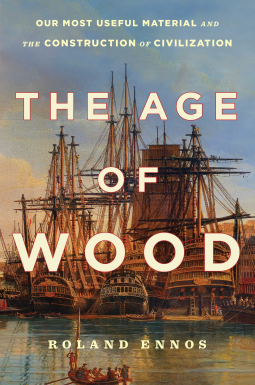
The Age of Wood
Our Most Useful Material and the Construction of Civilization
by Roland Ennos
This title was previously available on NetGalley and is now archived.
Send NetGalley books directly to your Kindle or Kindle app
1
To read on a Kindle or Kindle app, please add kindle@netgalley.com as an approved email address to receive files in your Amazon account. Click here for step-by-step instructions.
2
Also find your Kindle email address within your Amazon account, and enter it here.
Pub Date Dec 01 2020 | Archive Date Dec 01 2020
Description
As the dominant species on Earth, humans have made astonishing progress since our ancestors came down from the trees. But how did the descendants of small primates manage to walk upright, become top predators, and populate the world? How were humans able to develop civilizations and produce a globalized economy? Now, in The Age of Wood, Roland Ennos shows for the first time that the key to our success has been our relationship with wood.
Brilliantly synthesizing recent research with existing knowledge in fields as wide-ranging as primatology, anthropology, archaeology, history, architecture, engineering, and carpentry, Ennos reinterprets human history and shows how our ability to exploit wood’s unique properties has profoundly shaped our bodies and minds, societies, and lives. He takes us on a sweeping ten-million-year journey from Southeast Asia and West Africa where great apes swing among the trees, build nests, and fashion tools; to East Africa where hunter gatherers collected their food; to the structural design of wooden temples in China and Japan; and to Northern England, where archaeologists trace how coal enabled humans to build an industrial world. Addressing the effects of industrialization—including the use of fossil fuels and other energy-intensive materials to replace timber—The Age of Wood not only shows the essential role that trees play in the history and evolution of human existence, but also argues that for the benefit of our planet we must return to more traditional ways of growing, using, and understanding trees.
A winning blend of history and science, this is a fascinating and authoritative work for anyone interested in nature, the environment, and the making of the world as we know it.
Available Editions
| EDITION | Other Format |
| ISBN | 9781982114732 |
| PRICE | $29.00 (USD) |
| PAGES | 336 |
Average rating from 8 members
Featured Reviews
Mr. Ennos, I Read This Book On A Kindle. ;) This was a fascinating and at times novel look at how wood - not stone or metals - has allowed and even encouraged human biological and civilizational evolution. Written by a British academic-engineer, this book looks to the bioengineering of woods of various forms and how the material's strengths and versatilities have allowed so much human progress, from eras before homo sapien sapien appeared through the future of the species. While the text does have a couple of weaknesses - he assumes that the book will be read on paper and there is a distinct lack of bibliography, at least in this advanced review copy I read - overall the book really is an amazing look at an oft-overlooked feature of human history. Very much recommended.
 Jason P, Educator
Jason P, Educator
I’m a sucker for books marketed as “the complete history of (some noun that is completely overlooked in history but probably very important)”, as are many. Mark Kurlansky has made a career out of it with Salt, Milk!, and Cod. I was excited for but ultimately disappointed with Timothy Winegard’s The Mosquito. But I loved Judith Flanders’ history of alphabetical order, A Place for Everything (I even interviewed her about it), and I am looking forward to reading Flanders’ 2017 history of Christmas as well. What I didn’t expect was to be completely enthralled with a new addition to the microhistory genre, Roland Ennos’ The Age of Wood.
Ennos argues that through all of human history: the “stone age”, “bronze age”, and “iron age”, our most useful material was always wood. It even has a large effect on society today, despite industrialization pushing it more towards the periphery. Thus, most of human history could be called “The Age of Wood”. He tells a story in the introduction about Britain’s need for trees tall enough and wide enough to serve as masts for their ships. In Britain’s American colonies, Ennos writes:
White pine trees above twenty-four inches in trunk diameter were marked with three strokes of a hatchet in the shape of an upward-pointing arrow and were deemed to be crown property. Unfortunately, this policy soon proved to be wildly unpopular and totally unenforceable. Colonists continued to fell the huge trees and cut them into boards twenty-three inches wide or less, to dispose of the evidence. Indeed wide floorboards became highly fashionable, as a mark of an independent spirit.
As a matter of fact, the unenforceable British laws about pine trees precipitated the Pine Tree Riot, which began when “sawmill owners from Weare, New Hampshire, refused to pay a fine for sawing up large white pines”. Ennos asserts that the Pine Tree Riot “became a major inspiration for the much more famous Boston Tea Party in December 1773.” A little-known riot over wood regulations was a significant step on the road to American independence.
It’s not hard to think of wood as being so significant in the 1600s and 1700s, however. It is much more difficult to see its properties as being important today, save for making paper and building the occasional fire for fun. Ennos argues, however, that there are many contemporary uses for wood because of its unique properties. When stone buildings took over the architecture of Europe and Central Asia, wood was still used in China and Japan because of its structural properties. The Forbidden City in Beijing is built of wood, though it could easily have been made of stone. They also build all the joints at right-angles to each other instead of triangulated beams like Western architecture. Why?
Recent research by Chinese engineers shows that the flexible design of the buildings and the shock-absorbing dougong joints protect them from damage. As an earthquake hits, and the ground moves around, the pillars sway, while the inertia of the heavy roof keeps it still and the energy is absorbed within the dougong joints. Tests on models have shown that these buildings can withstand shocks that reach over 10 on the Richter scale, more powerful than any earthquake yet recorded. It’s no surprise then that the Forbidden City has stood for six hundred years.
It is details like these that separate Ennos’ The Age of Wood from other hypothetical versions of this history. While scientific specificities fly over my head sometimes, the general gist of the information leaves the impression that there is a lot of expertise in this work that is put to great use. Every age of human history is impacted by wood, yet Ennos is not afraid to put to death any myths that have arisen concerning its history. As a bonus, it’s a manageable 336 pages. If a broad view of history interests you, yet you are also enthralled with how specific properties of one natural material have dramatic effects on that history, The Age of Wood is where you want to abide, if even for a short time.
I received a review copy of The Age of Wood courtesy of Scribner and NetGalley, but my opinions are my own.
Readers who liked this book also liked:
Justin Feinstein
General Fiction (Adult), Humor & Satire, Sci Fi & Fantasy


















